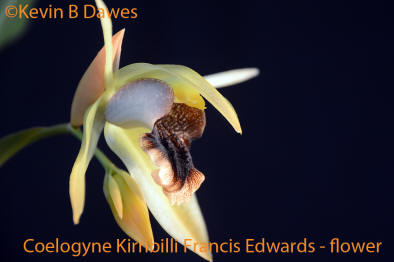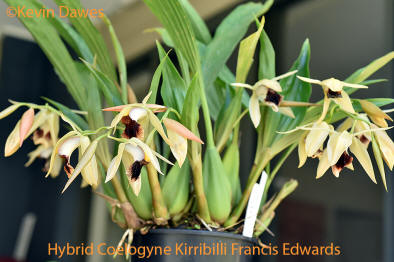The very attractive pod parent Coelogyne marmorata (named after the marbling patterns on the inside lobes of the flower) has multiple simultaneously opening flowers that are fairly upright in habit. There is also a slightly smaller and darker flowered variety of Coelogyne marmorata without the extensive white on the flower lip. The pollen parent, Coelogyne xyrekes, is one of the Speciosae Section of Coelogynes which includes the widely grown Coelogyne speciosa. Coelogyne xyrekes is known for its dark colouring, especially on the lip, but also for its unusual mushroom pink tinge in the sepals and petals. Its large flowers are quite downward facing and the small number of flowers open sequentially.
Coelogyne marmorata x Coelogyne xyrekes is a new, interesting and attractive primary hybrid in which the inflorescence emerges from a developing new psuedobulb, as is the case with both its parents (i.e. synanthous). The psuedobulbs are quadrangular in cross-section, again, as in the case of both parents. The deciduous bracts, especially on opening bracts, have a slightly apple rose tint, probably influenced by the mushroom pink colouring of the Coelogyne xyrekes flower.
Whereas Coelogyne marmorata has 3 to 5 simultaneously opening, fairly erect flowers, the hybrid has almost completely lost this trait in favour of 2 to 3 very downward-facing, sequentially opening flowers like the habit of Coelogyne xyrekes and the other members of Coelogyne Section Speciosae, e.g. Coelogyne speciosa. The pollen parent has also strongly influenced the lip colouring on the hybrid, resulting in very dark markings that overpower the brighter white lip marking of Coelogyne marmorata and making the marbling patterns on the inside lobes very dark.
The hybrid has compromised flower size to around 7cm across. It has continued the slightly crenated lip margins evident in both parents and the lateral keels are long and narrow as in the case of both parents.
Two prominent keels from Coelogyne xyrekes have carried through and a small but well defined central keel travels well out onto the lip.
The column of the hybrid is very similar to those of both parents but the influence of Coelogyne xyrekes'. more creamy colours have slightly muted the bright orange and lime colouring of Coelogyne marmorata's column and hood.
The leaves of both parents and the hybrid off-spring are very similar, all having five strongly defined veins that form very tactile ridges on the undersides of the leaves.
Negatives: This hybrid has lost some of the attractive traits of its parents including the perfume (or 'smell'!) of Coelogyne marmorata. The flower is too much a compromise of both beautiful and desirable parents. It is also very similar to other Coelogyne Speciosae-based hybrids such as Kirribilli Joyce and Coelogyne Kirribilli Norm.
Rating: ♦♦♦ This is another new primary Coelogyne hybrid and part of a program to demonstrate that Coelogynes are easy to hybridise. It is a very free flowering Coelogyne and despite the negative comments above makes a very attractive orchid.
Registered: My Kirribilli bred hybrid was officially registered by the RHS in January 2015 and has been named after my grandfather, Francis Edwards, 1872 to 1929, a farmer from the Bathurst area of NSW and who was father to Marie Dawes of 'Kirribilli'.
| < Coel Kirribilli Ezekiel | Coel Kirribilli Gillian > |

